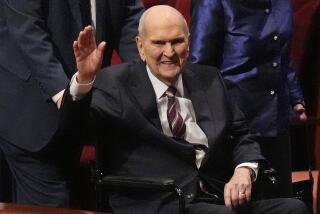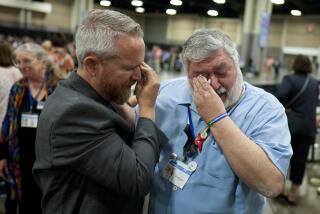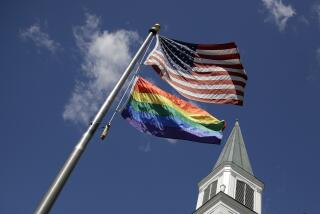Tuning In to Teen-Agers Is High on Methodists’ Agenda
- Share via
SALT LAKE CITY — When the United Methodist Church held its first youth conference in 1947, portable showers and double-decker Army cots had to be set up in the halls to accommodate the 10,000 teen-agers it drew.
In the years that followed, however, teen-agers seemed to lose interest in anything religious, finding it boring or thinking it offered them little.
Sunday school enrollment was dropping and church leaders were stymied by the challenge of attracting teen-agers back into the fold.
So, by the late 1980s, Methodist leaders set out to make church fun again and resumed the national conferences that had united teen-agers in the 1940s and ‘50s.
This year’s four-day “Let’s Rock! Building Up the People of God” conference, held earlier this month in downtown Salt Lake City, drew more than 4,000 youths from every state and several nations, including the Philippines, Germany, Angola, Burundi, India and Brazil.
Many teen-agers earned the $150 conference registration fee themselves; others were sponsored by their churches.
Still, attendance was less than half that of the first conference in 1947.
Part of the problem, organizers said, is that youths do not feel their own beliefs and efforts are taken seriously.
“Children and youth are devalued in society, and I think that churches tend to mirror that,” said Cindy Davenport, director of youth and young adult ministries for the United Methodist Church’s General Board of Discipleship.
“Young people do not have the opportunity to lead,” she said. “They need to know they can make an impact.”
Church leaders hope that sponsoring the youth conferences every three or four years in various cities will make the difference.
The meetings were discontinued after the Methodist churches and the Evangelical United Brethren merged in 1968. But they resumed 20 years later, in 1988, after church leaders recognized that the conferences helped encourage teen-agers to join and participate in their local churches.
According to church figures, there were more than 1 million youths enrolled in United Methodist Church Sunday school in 1947, compared to just 515,816 in 1993.
“It’s important, as with any institution that wants growth, that it be in tune and attuned to the people who are a part of it,” said Jerald Scott, national coordinator of the church’s Special Program on Substance Abuse and Related Violence.
“And of course, our youth are very important because they are the future of our church,” he said.
To attract today’s teen-agers, church and youth leaders knew they had to make the conference modern and interesting. The result was hard-hitting workshops with speakers on such topics as racism, AIDS, substance abuse, sex and violence.
Likewise, the religious backgrounds of workshop speakers were as diverse as their topics--including members of the Presbyterian, Mormon, Catholic and Episcopal faiths.
One of the speakers, Leticia Medina, a former gang prevention director for the Salt Lake City school system, told of the violence and fear she confronted while a member of a Los Angeles gang during the 1970s.
“I have seen lots of kids very active in churches still become gang members,” said Medina, who is Catholic. “But some religious groups tend to deny it is a religious issue. Their reasoning is that if they follow church doctrine by the letter, it won’t be a problem.”
The only way Medina was able to break from her gang was by leaving her husband, who was an influential gang leader, and starting a new life with her two young children in Utah. She relied on faith and help from members of her church.
Such stories demonstrate how youths can depend on their church, said 18-year-old Lucy Mends of Houston. “The church is stable. A lot of things you can’t count on, but the church is always there.”
Mends was among the teen-agers who helped organize this year’s conference for their peers, which included junior high students for the first time.
It also was the first year that youths participated in their choice of community service projects, from making lunches for the homeless to building a home in West Valley City for Habitat for Humanity.
And in the evening, the teen-agers rocked to the music of various Christian bands.
“We have to start reaching out to the youth,” said Heather Horton, 18, of Prospect, Ky.
The goal of the conferences, she said, is to let teen-agers know the church “adds a degree of spirituality in your life and a deeper meaning that you can’t find any other place.”
More to Read
Sign up for Essential California
The most important California stories and recommendations in your inbox every morning.
You may occasionally receive promotional content from the Los Angeles Times.













